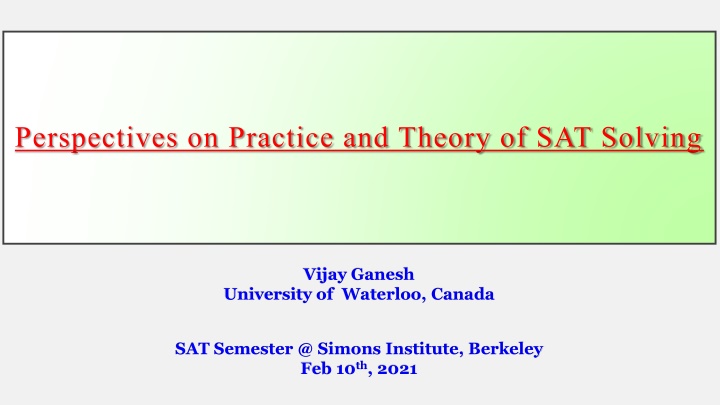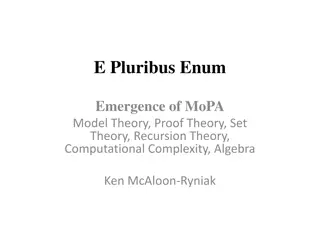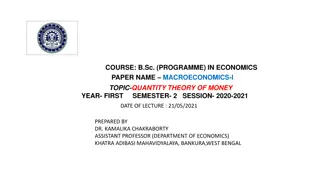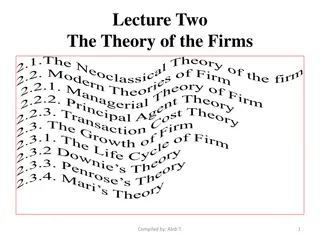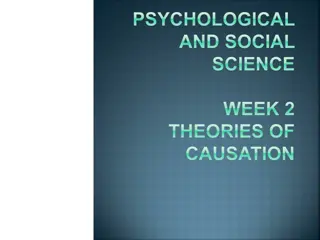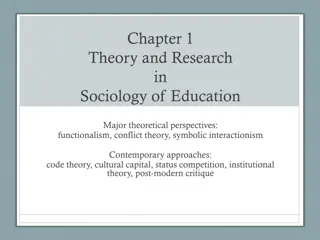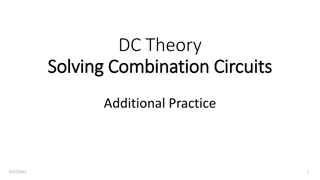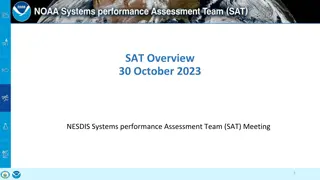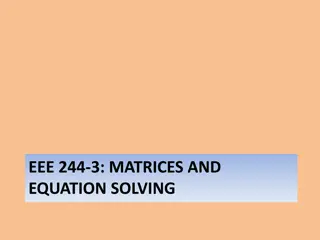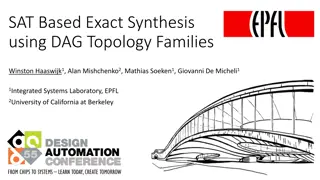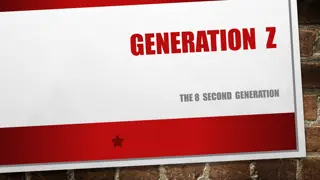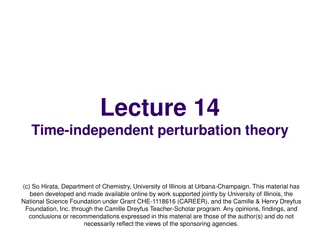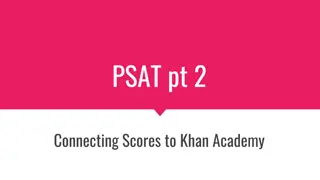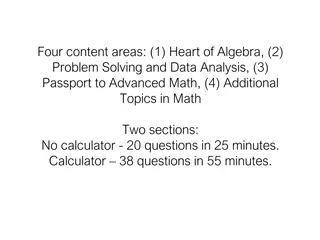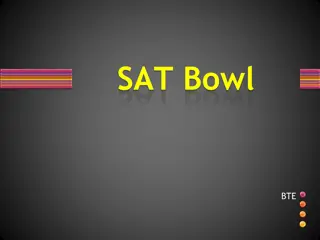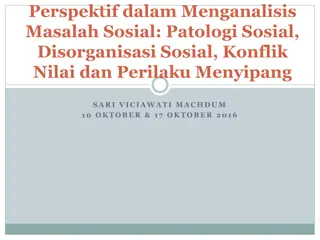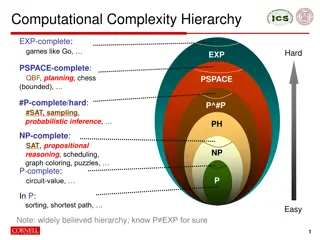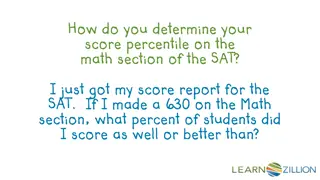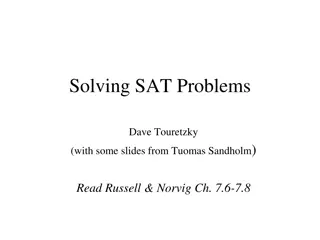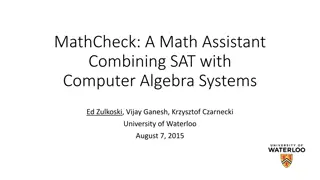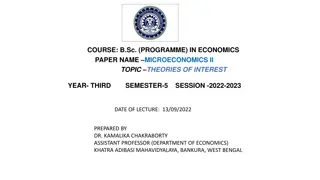Perspectives on Practice and Theory of SAT Solving
"Exploring the intersection of practice and theory in SAT solving, this presentation by Vijay Ganesh delves into insights from the University of Waterloo and the Simons Institute. Gain valuable perspectives on the latest advancements in SAT solving and its applications."
Download Presentation

Please find below an Image/Link to download the presentation.
The content on the website is provided AS IS for your information and personal use only. It may not be sold, licensed, or shared on other websites without obtaining consent from the author.If you encounter any issues during the download, it is possible that the publisher has removed the file from their server.
You are allowed to download the files provided on this website for personal or commercial use, subject to the condition that they are used lawfully. All files are the property of their respective owners.
The content on the website is provided AS IS for your information and personal use only. It may not be sold, licensed, or shared on other websites without obtaining consent from the author.
E N D
Presentation Transcript
Perspectives on Practice and Theory of SAT Solving Vijay Ganesh University of Waterloo, Canada SAT Semester @ Simons Institute, Berkeley Feb 10th, 2021
Talk Outline The central question in SAT/SMT solving Unreasonable Effectiveness of SAT/SMT Solvers for many classes of industrial instances. At the same time, slow for others (e.g., crypto) Structural view of industrial instances. Current-best understanding and pitfalls Solvers = proof systems + machine learning view Separation results for solver configurations (e.g., CDCL with restarts and without restarts) From practice to theory leveraging solvers for theory Open problems and directions Workshop talks 2
PART I Context and Motivation The Central Question in Solving 3
The Central Question in Solver Research Why are Solvers Efficient? Why are SAT solvers efficient? After all, the Boolean SAT problem is NP-complete, believed to be intractable. Clearly there is a gap between the map (complexity theory) and the territory (algorithm). Can we close this gap between theory and practice in a way that not only deepens our theoretical understanding, but also paves way for better solver design? (We can leverage already well- developed complexity-theoretic tools such as parameterized complexity to close this gap.) Finally, we know of classes of instances obtained from applications that are hard for solvers (e.g., Crypto). How do we explain the difficulty of solving such instances? Many of these questions have been open for over two decades. 4
The Generality of the Central Question This question also applies to SMT, CP, Answering this question for SAT would also impact more general settings, since this phenomena applies to many formal reasoning systems, e.g., CP, QBF, model checkers, SMT solvers, first-order provers, , where problems range from NP-complete, PSPACE-complete, NEXPTIME-complete, (Also applies to optimization cousins ILP, MAXSAT, ) This phenomenon extends to many other settings, where practical algorithms seem to defy theoretical expectations set by worst-case analysis Richard Karp and many other researchers have suggested that this gap between the success of practical algorithms and the worst-case complexity-theoretic view of algorithms is one of the most important questions in the context of algorithm design and complexity 5
Sub-questions Why are Solvers Efficient? As has been discussed already during the bootcamp (see talks by Sam Buss and others), CDCL solvers are best modelled as proof search systems Key result: CDCL solvers are polynomially equivalent to general resolution [PD 11, AFT 11] While this equivalence provides a framework for analysis of CDCL solvers, it doesn t answer the question of why solvers are efficient on some classes of instances Hence, the question of why solvers are efficient can be pared down to: What formula structure/parameters (and range of values for them) result in short proofs (for UNSAT formulas)? Why is it possible for CDCL solvers to find such short proofs efficiently (i.e., automatable under appropriate parameterization) Recent interesting result: Resolution is not automatable, unless P=NP [AM 20] 6
Target Conjectures and Results Why are Solvers Efficient? Parameterized upper bounds for CDCL algorithm One possibility is 2? ?1,?2.????(?)for appropriate values of real-world parameters ?1,?2 Alternatively, similar upper-bound for CDCL as PPSZ, but with real-world parameters Parameterized understanding of proof search and proof size Better practically-inspired lower bounds for Res (e.g., why are crypto instances hard for solvers?) Better understanding of solver configurations (e.g., CDCL - restarts < CDCL + restarts, ) Better solver design (e.g., stronger proof systems integrated into solvers, better ML-based proof rule sequencing and selecting methods, ) 7
PART II In Search of Empirical Understanding of Solvers via Parameters 8
Search for Complexity-theoretic Parameters Key Question Treewidth Community Structure Backdoors Q: Industrial instances have structure that is exploited by solvers. The question then is which of the proposed structural parameters have the best explanatory power, across a wide variety of instances? The goal of empirical work is to either rule-out or rule-in parameters for further theoretical analysis 9
Complexity-theoretic Understanding of Solvers Empirical Approach to Identify Good Parameters Final goal: Discover parameters that withstand a battery of well-designed empirical tests and are primed for further theoretical analysis. (it goes without saying that empirical analysis can never be conclusive or complete, because experiments are inherently contingent on a many factors such as sample size, solver settings, tools used, experimental design, etc. Also, the best we can hope for is correlations) Parameter must enable us to classify different kinds of SAT formulas into categories such as random, crafted, crypto, verification etc. (i.e., there must be evidence that real-world instance possess the appropriate structure) For appropriate range of values, the parameters must correlate well with solver running time (i.e., parameters useful as features in empirical hardness models) Instance-generator based scaling studies must validate our hypotheses 10
Parameters that have been (tentatively) Ruled Out CVR Lots of excitement in the 1990 s when the phase transition phenomenon was discovered [CKT 91], followed by the easy-hard-easy pattern [MSL 92]. However, it was later shown that this does not hold up under scaling studies [CDASV 03] Treewidth Unfortunately, empirically treewidth does not correlate with solver runtime [Mateescu 11] Pathwidth/branchwidth These are polynomially related to treewidth and hence unlikely to serve as good parameters (for the same reason treewidth fails) Backdoor and many variants Similar problem as treewidth. Instances with small backdoor hard to solve, large backdoors easy to solve [Zulkoski 18] Community structure While promising empirically, it is easy to show theoretically that formulas with good community structure can be hard for solvers [Zulkoski 18] Many of these parameters are very intuitive and easy to work with theoretically. However, they fall apart upon contact with reality. 11
Parameters that have not yet been Ruled Out Merge A generalization of subsumption Hierarchical community structure Variant of community structure, but does not have obvious counterexamples (e.g., formulas with good hierarchical community structure cannot be expanders) Power law Degree of variable occurrences is highly unbalanced . A few variables occur very often, but most others occur only a few times 12
Proof Systems Proof-complexity of Solvers General resolution The rule is form of modus ponens. Proof is a directed acyclic graph (DAG). ?1 ?? ?? ?1 ?? ?1 ?? 1 ?1 ?? Merge resolution Biased towards deriving clauses that share literals. (In the clauses below, ? is a disjunction of literals.) ? ?? ?? ? ? ?? 1 Unit resolution One clause must be unit. Proof is a DAG. ?? ?? ?1 ?? ?1 ?? Tree resolution Same rules as general resolution. Proof is a tree. Not allowed to reuse lemmas unlike DAG proofs. 13
Resolution and Merges Mergeability and CDCL SAT Solvers ? ?? ?? ? ? ? ? ?? ?? ? ? ? ?? ?? ( ?? ??) (??) ?? ?? ( ?? ??) ( ??) ?? ( ??) 14
Mergeability Number of Merges vs. Learnt Clause Size 15
PART III Solvers = Proof Systems + Machine Learning 16
Solvers = Proof Search Systems+Machine Learning The Practice of Proof Systems Solvers = Proof Search Systems is a well-known abstraction of solvers and provers. This is a powerful way to design solvers, although non-symbolic DNN-based SAT solvers do exist (e.g., NeuroSAT) How can we leverage this abstraction to design better SAT/SMT solvers? One way is to strengthen the reasoning engine inside a solver, e.g., CDCL(T) or programmatic SAT Another is to design optimization heuristics inside solvers with machine learning (ML) methods. This led to the design of award-winning MapleSAT (and variants). 5 different ML-based heuristics (branching, splitting, restarts, initialization, and algorithm selection). Our work has been widely adopted, adapted, extended [HVC15, SAT16, AAAI16, SAT17, IJCAI18, CP20, ICML20] 17
Conflict-Driven Clause-Learning SAT Solver Solver = Proof Search System + ML Input SAT Instance Propagate() (BCP) Conflict? All Vars Assigned? Conflict Analysis() Return SAT Top-level Conflict? Branch() Return UNSAT Backjump() GRASP Solver: [MS96] ZChaff Solver: [MMZZM01] 18
CDCL with Deductive Feedback Loop Reinforcement Learning Partial Assignment Environment Agent Decision Heuristic (ML) Clause Learning (Proof System) Learnt Clause 19
PART IV Understanding CDCL Solver Configurations Restarts 20
Understanding the Power of Restarts Big open question We know that CDCL + restarts is polynomially equivalent to Res. Does this equivalence also hold for CDCL w/o restarts? Theorem 1: The first CDCL configuration (with restarts) below is exponentially faster than the second CDCL configuration (w/o restarts) on a class of satisfiable instances we refer to as Ladder formulas 1. CDCL + backtracking + non-deterministic variable selection + randomized value selection + restarts 2. CDCL + backtracking + non-deterministic variable selection + randomized value selection - restarts Theorem 2: The first CDCL configuration (with restarts) below is exponentially faster than the second CDCL configuration (w/o restarts) on a class of unsatisfiable instances we refer to as pitfall formulas 1. CDCL + backjumping + VSIDS variable selection + phase-saving value selection + restarts 2. CDCL + backjumping + VSIDS variable selection + phase-saving value selection - restarts 21
PART V From Practice to Theory Using Solvers for Solving Complexity Questions 22
From Practice to Theory Solving concrete circuit complexity questions using solver For example, minimum number of multiplications needed for the 3x3 Boolean matrix multiplication problem (Ryan Williams posted this as a polymath problem.) Study of novel proof systems inspired by practice (e.g., DRAT or interference-based proof systems) Using solvers to test conjectured classes of instances as lower bounds for corresponding proof systems Solving combinatorics problems via SAT (e.g., find Ramsey(5)) 23
PART V Open Problems 24
Open Problems (Theory and Practice) Parameterized upper bound for CDCL explaining the power of CDCL solvers via parameters Crypto hardness why are crypto problems (e.g., SHA-1 collision/inversion, breaking DES) hard for CDCL SAT solvers? Ideally, construct instances that are morally like crypto, and show they are hard for Res? Understanding solver configurations is CDCL w/o restarts polynomially equivalent to Res? Do restart help primarily with proof search and not proof size? How about other configurations such as CDCL with 1UIP vs. CDCL without? Tight upper bound on BCP algorithm not aware of any work on complexity analysis of 2-watched scheme ML-based solver heuristics (combining deduction with ML) can we do better than 1UIP? Feedback on encodings can we design a method to give feedback to the user about how their encodings can be improved? Faster solvers for multiplication multiplication circuits can be hard for SAT. How can we do better? 25
PART VI Workshop Talks 26
Summary of Scheduled Workshop Talks Date Theme Speakers Feb 10th Theoretical Foundation of Solvers: Context, Directions and Open Problems Vijay Ganesh, David Mitchell, Laurent Simon Feb 17th Theory and Practice of Structure of SAT Instances Stefan Szeider, Jordi Levy, Ralf Rothenberger Feb 24th Theory and Practice of Encodings (encoding showcase) Oliver Kullmann, Ciaran McCreesh, Maria Bonet Mar 3rd Proof Complexity Toolbox Robert Robere, Susanna de Rezende Joanna Ochremiak,.. Marc Vinyals, Noah Fleming, Ian Li, Mar 10th Recent Advances in Proof Complexity of Solvers Mar 17th Non-CDCL Solvers Marijn Heule, Jakob Nordstrom, Zhiwei Zhang Maria Paola Bonacina, Daniel Selsam, Mar 24th Theorem Proving Strategies and Decision Procedures for Satisfiability Richard M. Karp Public Lecture Mar 31st TBD Apr 7th Machine Learning for Solvers TBD 27
REFERENCES [DPLL62] Davis, M., Putnam, H., Logemann, G. and Loveland, D. A Machine Program for Theorem Proving. CACM 1962 [MS96] Marques-Silva, J.P. and Sakallah, K.A. GRASP: A New Search Algorithm for Satisfiability. ICCAD 1996 [MMZZM01] Moskewicz, M.W., Madigan, C.F., Zhao, Y., Zhang, L. and Malik, S. Chaff: Engineering an efficient SAT solver. DAC 2001 [BKS03] Beame, P., Kautz, H., Sabharwal, A. Understanding the Power of Clause Learning. IJCAI 2003 [WGS03] Williams, R., Gomes, C.P. and Selman, B. Backdoors to typical case complexity. IJCAI 2003 [BSG09] Dilkina, B., Gomes, C.P. and Sabharwal, A. Backdoors in the context of learning. SAT 2009 [KSM11] Katebi, H., Sakallah, K.A. and Marques-Silva, J.P. Empirical study of the anatomy of modern SAT solvers. SAT 2011 [AFT11] Atserias, A., Fichte, J., and Thurley, M. Clause Learning Algorithms with Many Restarts and Bounded-width Resolution. JAIR 2011 [PD11] Pipatsrisawat, K., and Darwiche, A. On the Power of Clause-learning SAT Solvers as Resolution Engines. AI 2011 [NGFAS14] Newsham, Z., Ganesh, V., Audemard, G. and Simon, L. Impact of community structure on SAT solver performance. SAT 2014 [LGZC15] Liang, J.H., Ganesh, V., Zulkoski, E., and Czarnecki, K. Understanding VSIDS branching heuristics in SAT solvers. HVC 2015. [LGPC16] Liang, J.H., Ganesh, V., Poupart, P., and Czarnecki, K. Learning Rate Based Branching Heuristic for SAT Solvers. SAT 2016 [LGPC+16] Liang, J.H., Ganesh, V., Poupart, P., and Czarnecki, K. Conflict-history Based Branching Heuristic for SAT Solvers. AAAI 2016 [RKG18] Robere, R., Kolkolova, A., Ganesh, V. Proof Complexity of SMT Solvers. CAV 2018 [SPG20] Scott, J., Panju, M., and Ganesh, V. Logic Guided Machine Learning AAAI 2020 [BBCGKV13] Babka et al. Complexity Issues related to Propagation Completeness. JAIR 2013 28
